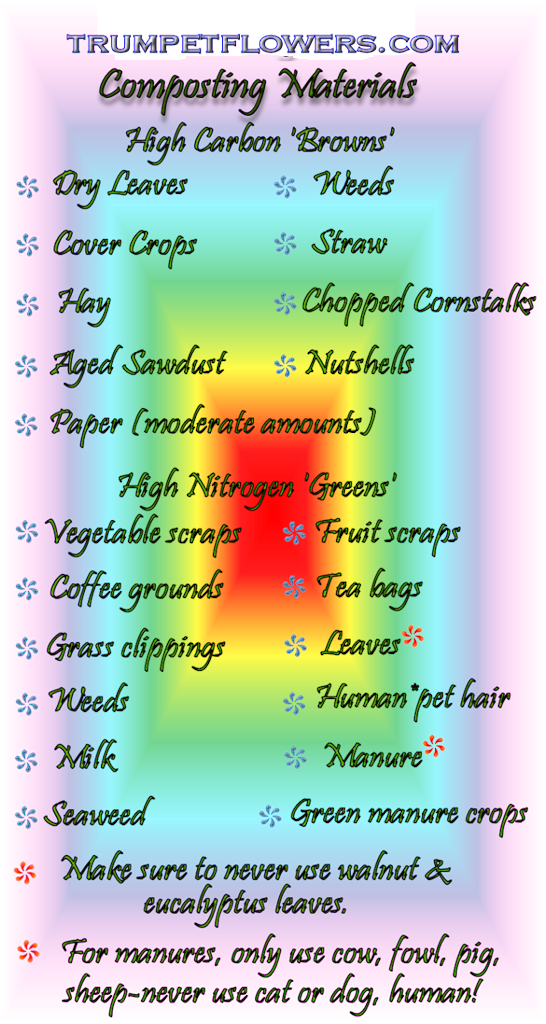Make Your Own
Compost
All About Composting
Composting Compostable Materials
 Compost is a made up of decomposed plant and animal (organic) materials. The making of compost is essentially the encouragement of things like fallen leaves, pulled weeds, grass clippings and some kitchen scrap to rot. The end result is a great soil conditioner, similar to the loam one would find just beneath rotting leaves on the floor of a dark forest. This material would be chock full of organically rich nutrients, bacteria and fungi that are beneficial to the soil, and other material that help support a healthy soil system.
Compost is a made up of decomposed plant and animal (organic) materials. The making of compost is essentially the encouragement of things like fallen leaves, pulled weeds, grass clippings and some kitchen scrap to rot. The end result is a great soil conditioner, similar to the loam one would find just beneath rotting leaves on the floor of a dark forest. This material would be chock full of organically rich nutrients, bacteria and fungi that are beneficial to the soil, and other material that help support a healthy soil system.
The two main ingredients in a soilborne organism's diet are nitrogen and carbon. Carbon provides energy for the organism to burn, while nitrogen builds protein. Carbon rich compost makings (called browns) are usually dry and dull colored, with the usual base of straw and dried leaves. On the other hand, nitrogen rich composts (called greens) are usually moist and messy. They contain manure, kitchen scraps, and fresh grass clippings.
Never put meat, cheese or any fatty products into a compost pile. Plastics and synthetic fabric should also be avoided. Many people put egg shells in the compost pile, for added calcium content. Of late, this has become known to not be such a good idea. Throw eggshells in the regular garbage to help keep your compost pile healthy.
In order to produce compost in an efficient manner, decay organisims need their nitrogen and carbon in an appropriate proportion, known as C/N (for Carbon, Nitrogen). If this ratio is too high in one element, the pile will not completely decompose. If the elelment is too low, the pile will lose the extra nitrogen to the air (as a gas) and the pile will begin to smell rotten. If you get your mixture just right, in the range of 25 to 30 parts carbon to 1 part nitrogen, the pile will heat up and 'cook,' giving you a rich compost material at the end of the process.
You don't have to make an exact science out of the brown and green materials you will be adding to the compost pile. Simply using two to three times more browns than greens will usually yield you a wonderfully loamy, rich compost. When collecting materials for your compost, get creative. As long as it is not composed of fat, meat, cheese or synthetics, the pile will break down properly.
You need aerobic soil bacteria in order to have a successful compost breakdown. All that means is that your compost pile must have air movement within it in order for the bacteria to be able to function and eat the materials you rpovided, break them down into smaller particles, providing you with the end result. The easiest way to do this is to turn the pile from time to time. This loosens up what has been breaking down, and adds air to the mixture.
The pile, while composting, will also need moisture. Don't get it too wet, but allow some moisture to stay in the pile. This keeps the bacteria that cause the decompostion to thrive, and further along the process. So squirt the pile every week or so if it looks like it's becoming too dry. A good time to do this is at the same time you are turning the pile to add aeration to it.
In an active compost pile, the decay organisms will generate their own heat, or energy, through the decompostion process. But in fall and winter, the pile may lose enough heat to stop the decay process and the pile will become idle. To help stop this from occuring, make sure the pile is large enough to hold it's own inner heat core. A compost pile that is at least 3 cubic feet (that's width, height, and length) should keep the bacteria living and working throughout cold months. If you have a particularlly harsh winter, protect the pile with added bales of straw piled up against it.
Build a compost pile close to the garden so adding new materials is easy for you. Keeping the pile moist is also easier if you have access to a garden hose within reach of it. You can either make a heap that you turn and wet every week or so, or go with the fancier compost bins premade by companies. You can even fashion up a bin yourself. Whatever you choose, just make sure the pile stays manageable. If you make it too big it will become strenuous and you'll have to work harder to get it to function. Stay within the 4 to 5 foot high and wide range for optimum ease and breakdown. Don't make it too tall either. It's own weight will compress it, and cause pockets of anaerobic bacteria, the kind we don't want.
Once you build it, it should take anywhere from 3 months to one full year before the compost is ready. This all depends upon how often you turn the pile. Forking the materials from the inside to the outside and reversed; spreads out the bacteria and allows them to move along faster. Make sure the inner core of the pile is heating up. That's when you know it is working.
Testing to see if the compost is ready is a simple process. Put a handful from the pile into a glass jar. Cap it with the lid. Place the jar in a warm and sunny location. Remove the lid and smell the contents. If it has a rotten smell, the compost is not yet ready. Wait another week and test it again. When it is ready, it will have an earthy smell, with no lingering nitrogen or ammonia ordor. Using it too soon means that there is still too much ammonia (nitrogen) present and this can burn the roots of your tender plants. Be patient, and only use good, well rotted compost.
To use your new compost, work it into the top few inches of soil with a metal rake. In late fall or early spring, work a 1 inch layer into the top 2 or 3 inches. You will need about 8 cubic feet (or two 30 gallon garbage cans full) for every 100 square feet of garden space. A newly constructed 4 by 3 foot compost heap will yield about 16 cubic feet of compost in the end.
Use compost as a side dressing. It makes a great slow release fertilizer anytime during the growing season. A 1 inch layer is sufficient to suppress most annual weeds.\ when used as a mulch. If you have an orchard, spread the compost in a circle beginning 1 foot from the tree's trunk and extend outward as far as the dripline. A dripline is the end of the tree's canopy of leaves/branches.
Compost tea is also very beneficial to your garden. To make compost tea, put a shovelful of compost into a burlap bag or an old pillowcase. Place this into a larger waterproof container and cover the compost with water. Allow it to steep in the water for 3 days. Strain the dark colored compost tea water off into another waterproof container and use it at the feet of your plants. Use the bulk compost as you normally would.
Compost also helps cover crops to decompose. When you are tilling under a fall or winter covercrop, adding compost to the soil and cuttings at this time places the right bacteria into the soil, and helps the covercrop to break down faster.

Tags: how to make compost, make your own compost, how to make your own compost, composting, make your own compost,



